Morpho-Syntactic Analysis of Quantifiers and Languages
VerifiedAdded on 2022/10/12
|12
|2077
|82
Homework Assignment
AI Summary
This document presents a detailed analysis of linguistic structures, focusing on case, number, and gender agreement in various languages, including Icelandic, Lezgian, and Mizo. The assignment examines how quantifiers interact with subjects, verbs, and other elements within sentences, highlighting the morpho-syntactic properties of each language. The solution explores word order, case marking, and the influence of factors such as gender and tense on verb conjugation and noun declension. The analysis includes examples from different language families, illustrating the diverse ways in which languages express grammatical relationships. The assignment also provides a language sketch of Mizo, detailing its syntax, noun phrase structure, and verb phrase structure, to provide a comprehensive understanding of language analysis.
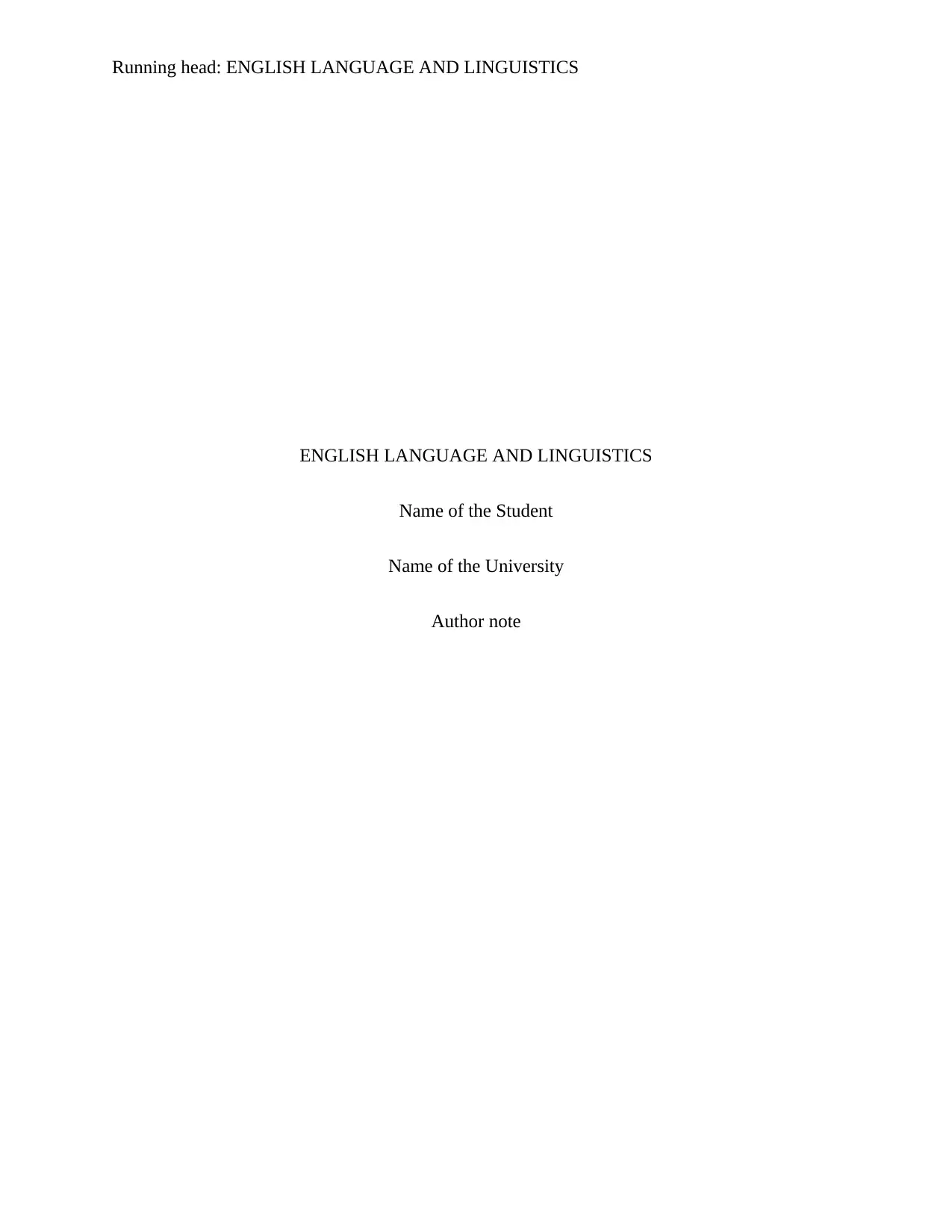
Running head: ENGLISH LANGUAGE AND LINGUISTICS
ENGLISH LANGUAGE AND LINGUISTICS
Name of the Student
Name of the University
Author note
ENGLISH LANGUAGE AND LINGUISTICS
Name of the Student
Name of the University
Author note
Paraphrase This Document
Need a fresh take? Get an instant paraphrase of this document with our AI Paraphraser
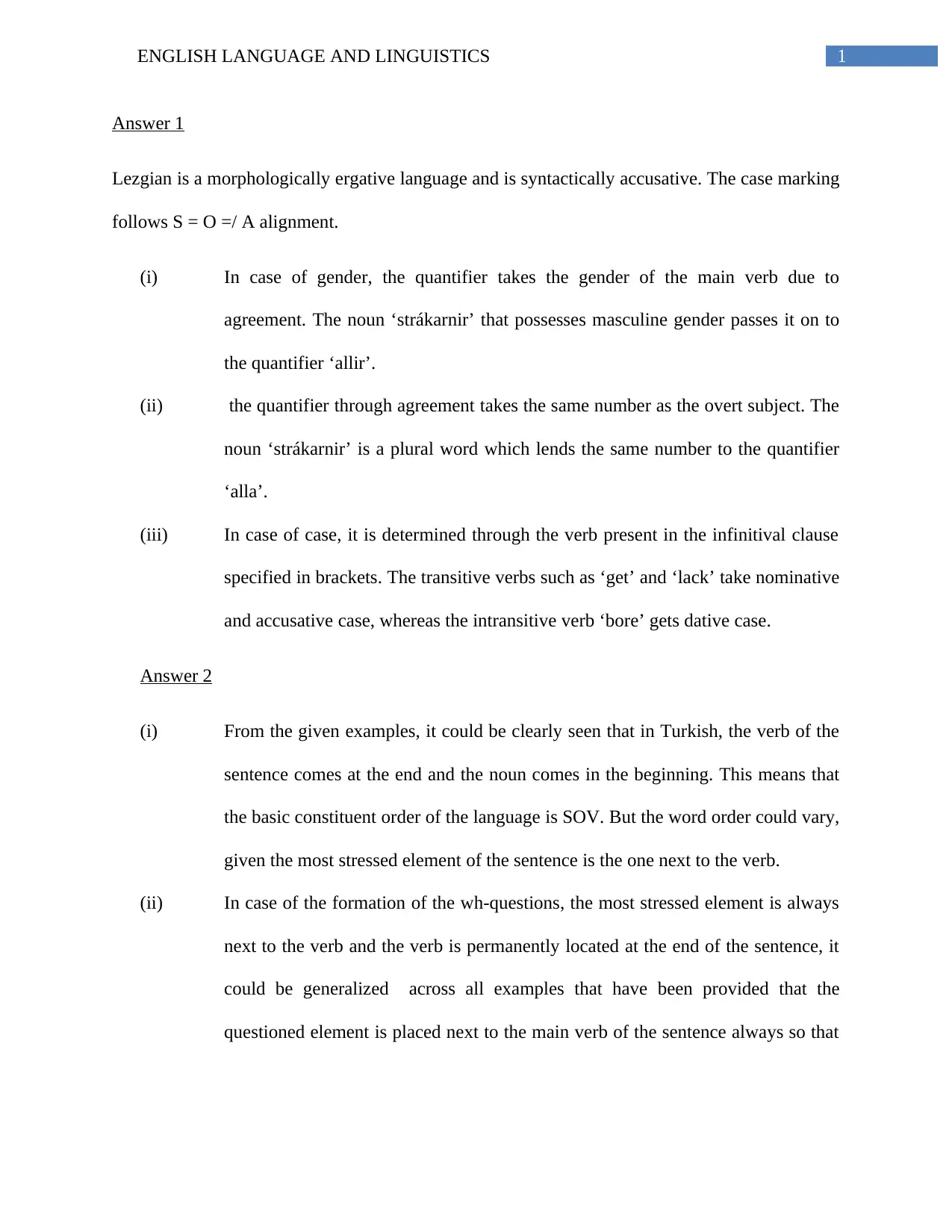
1ENGLISH LANGUAGE AND LINGUISTICS
Answer 1
Lezgian is a morphologically ergative language and is syntactically accusative. The case marking
follows S = O =/ A alignment.
(i) In case of gender, the quantifier takes the gender of the main verb due to
agreement. The noun ‘strákarnir’ that possesses masculine gender passes it on to
the quantifier ‘allir’.
(ii) the quantifier through agreement takes the same number as the overt subject. The
noun ‘strákarnir’ is a plural word which lends the same number to the quantifier
‘alla’.
(iii) In case of case, it is determined through the verb present in the infinitival clause
specified in brackets. The transitive verbs such as ‘get’ and ‘lack’ take nominative
and accusative case, whereas the intransitive verb ‘bore’ gets dative case.
Answer 2
(i) From the given examples, it could be clearly seen that in Turkish, the verb of the
sentence comes at the end and the noun comes in the beginning. This means that
the basic constituent order of the language is SOV. But the word order could vary,
given the most stressed element of the sentence is the one next to the verb.
(ii) In case of the formation of the wh-questions, the most stressed element is always
next to the verb and the verb is permanently located at the end of the sentence, it
could be generalized across all examples that have been provided that the
questioned element is placed next to the main verb of the sentence always so that
Answer 1
Lezgian is a morphologically ergative language and is syntactically accusative. The case marking
follows S = O =/ A alignment.
(i) In case of gender, the quantifier takes the gender of the main verb due to
agreement. The noun ‘strákarnir’ that possesses masculine gender passes it on to
the quantifier ‘allir’.
(ii) the quantifier through agreement takes the same number as the overt subject. The
noun ‘strákarnir’ is a plural word which lends the same number to the quantifier
‘alla’.
(iii) In case of case, it is determined through the verb present in the infinitival clause
specified in brackets. The transitive verbs such as ‘get’ and ‘lack’ take nominative
and accusative case, whereas the intransitive verb ‘bore’ gets dative case.
Answer 2
(i) From the given examples, it could be clearly seen that in Turkish, the verb of the
sentence comes at the end and the noun comes in the beginning. This means that
the basic constituent order of the language is SOV. But the word order could vary,
given the most stressed element of the sentence is the one next to the verb.
(ii) In case of the formation of the wh-questions, the most stressed element is always
next to the verb and the verb is permanently located at the end of the sentence, it
could be generalized across all examples that have been provided that the
questioned element is placed next to the main verb of the sentence always so that
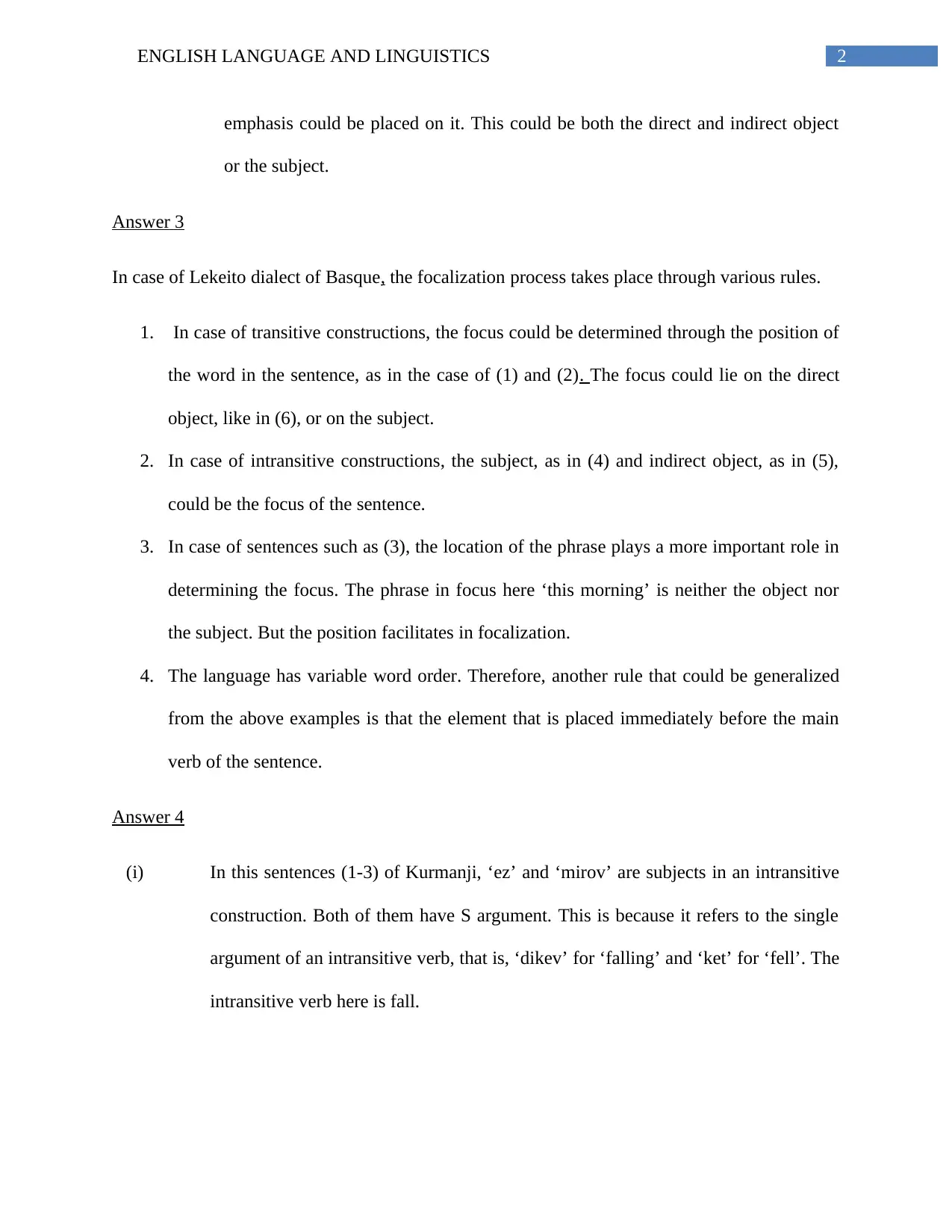
2ENGLISH LANGUAGE AND LINGUISTICS
emphasis could be placed on it. This could be both the direct and indirect object
or the subject.
Answer 3
In case of Lekeito dialect of Basque, the focalization process takes place through various rules.
1. In case of transitive constructions, the focus could be determined through the position of
the word in the sentence, as in the case of (1) and (2). The focus could lie on the direct
object, like in (6), or on the subject.
2. In case of intransitive constructions, the subject, as in (4) and indirect object, as in (5),
could be the focus of the sentence.
3. In case of sentences such as (3), the location of the phrase plays a more important role in
determining the focus. The phrase in focus here ‘this morning’ is neither the object nor
the subject. But the position facilitates in focalization.
4. The language has variable word order. Therefore, another rule that could be generalized
from the above examples is that the element that is placed immediately before the main
verb of the sentence.
Answer 4
(i) In this sentences (1-3) of Kurmanji, ‘ez’ and ‘mirov’ are subjects in an intransitive
construction. Both of them have S argument. This is because it refers to the single
argument of an intransitive verb, that is, ‘dikev’ for ‘falling’ and ‘ket’ for ‘fell’. The
intransitive verb here is fall.
emphasis could be placed on it. This could be both the direct and indirect object
or the subject.
Answer 3
In case of Lekeito dialect of Basque, the focalization process takes place through various rules.
1. In case of transitive constructions, the focus could be determined through the position of
the word in the sentence, as in the case of (1) and (2). The focus could lie on the direct
object, like in (6), or on the subject.
2. In case of intransitive constructions, the subject, as in (4) and indirect object, as in (5),
could be the focus of the sentence.
3. In case of sentences such as (3), the location of the phrase plays a more important role in
determining the focus. The phrase in focus here ‘this morning’ is neither the object nor
the subject. But the position facilitates in focalization.
4. The language has variable word order. Therefore, another rule that could be generalized
from the above examples is that the element that is placed immediately before the main
verb of the sentence.
Answer 4
(i) In this sentences (1-3) of Kurmanji, ‘ez’ and ‘mirov’ are subjects in an intransitive
construction. Both of them have S argument. This is because it refers to the single
argument of an intransitive verb, that is, ‘dikev’ for ‘falling’ and ‘ket’ for ‘fell’. The
intransitive verb here is fall.
⊘ This is a preview!⊘
Do you want full access?
Subscribe today to unlock all pages.

Trusted by 1+ million students worldwide
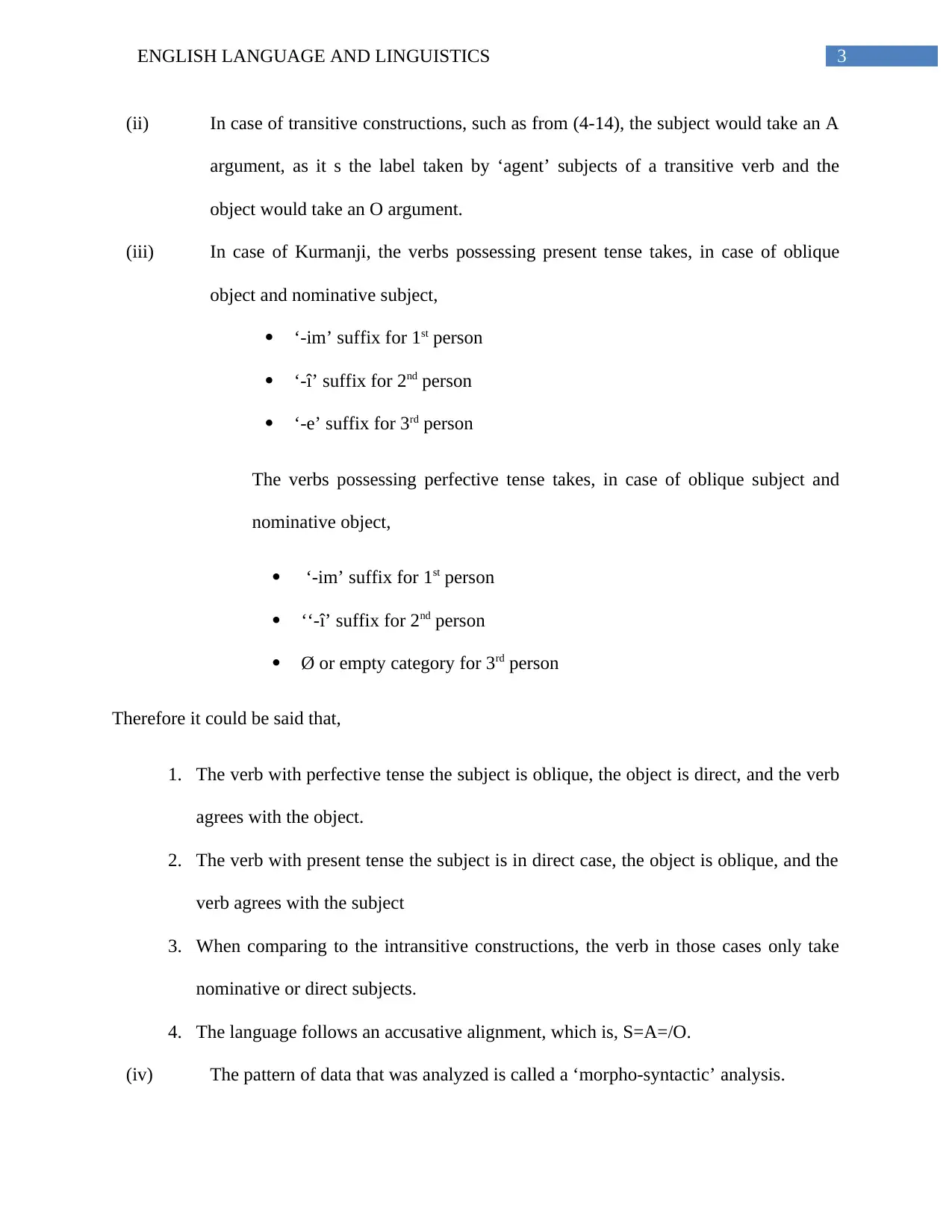
3ENGLISH LANGUAGE AND LINGUISTICS
(ii) In case of transitive constructions, such as from (4-14), the subject would take an A
argument, as it s the label taken by ‘agent’ subjects of a transitive verb and the
object would take an O argument.
(iii) In case of Kurmanji, the verbs possessing present tense takes, in case of oblique
object and nominative subject,
‘-im’ suffix for 1st person
‘-î’ suffix for 2nd person
‘-e’ suffix for 3rd person
The verbs possessing perfective tense takes, in case of oblique subject and
nominative object,
‘-im’ suffix for 1st person
‘‘-î’ suffix for 2nd person
Ø or empty category for 3rd person
Therefore it could be said that,
1. The verb with perfective tense the subject is oblique, the object is direct, and the verb
agrees with the object.
2. The verb with present tense the subject is in direct case, the object is oblique, and the
verb agrees with the subject
3. When comparing to the intransitive constructions, the verb in those cases only take
nominative or direct subjects.
4. The language follows an accusative alignment, which is, S=A=/O.
(iv) The pattern of data that was analyzed is called a ‘morpho-syntactic’ analysis.
(ii) In case of transitive constructions, such as from (4-14), the subject would take an A
argument, as it s the label taken by ‘agent’ subjects of a transitive verb and the
object would take an O argument.
(iii) In case of Kurmanji, the verbs possessing present tense takes, in case of oblique
object and nominative subject,
‘-im’ suffix for 1st person
‘-î’ suffix for 2nd person
‘-e’ suffix for 3rd person
The verbs possessing perfective tense takes, in case of oblique subject and
nominative object,
‘-im’ suffix for 1st person
‘‘-î’ suffix for 2nd person
Ø or empty category for 3rd person
Therefore it could be said that,
1. The verb with perfective tense the subject is oblique, the object is direct, and the verb
agrees with the object.
2. The verb with present tense the subject is in direct case, the object is oblique, and the
verb agrees with the subject
3. When comparing to the intransitive constructions, the verb in those cases only take
nominative or direct subjects.
4. The language follows an accusative alignment, which is, S=A=/O.
(iv) The pattern of data that was analyzed is called a ‘morpho-syntactic’ analysis.
Paraphrase This Document
Need a fresh take? Get an instant paraphrase of this document with our AI Paraphraser
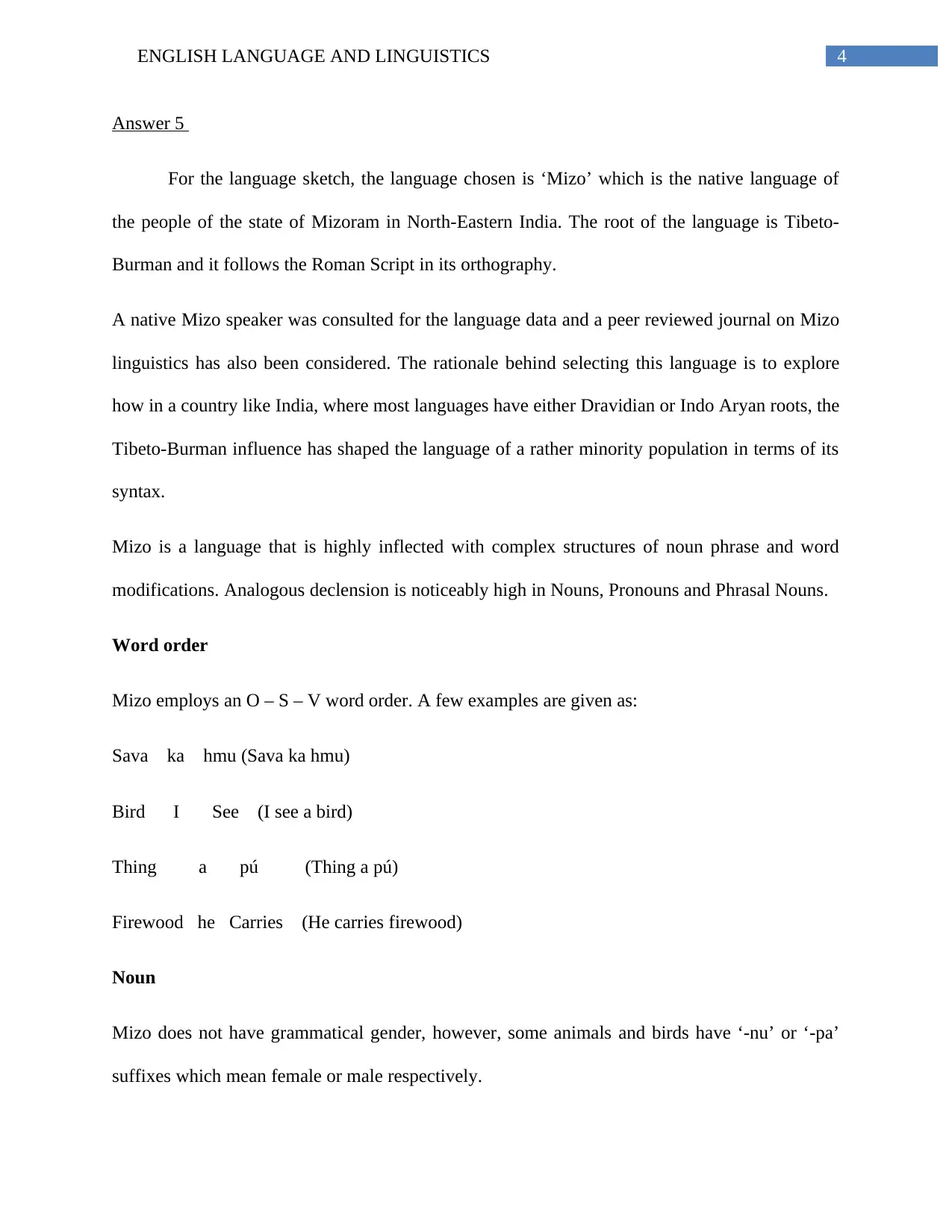
4ENGLISH LANGUAGE AND LINGUISTICS
Answer 5
For the language sketch, the language chosen is ‘Mizo’ which is the native language of
the people of the state of Mizoram in North-Eastern India. The root of the language is Tibeto-
Burman and it follows the Roman Script in its orthography.
A native Mizo speaker was consulted for the language data and a peer reviewed journal on Mizo
linguistics has also been considered. The rationale behind selecting this language is to explore
how in a country like India, where most languages have either Dravidian or Indo Aryan roots, the
Tibeto-Burman influence has shaped the language of a rather minority population in terms of its
syntax.
Mizo is a language that is highly inflected with complex structures of noun phrase and word
modifications. Analogous declension is noticeably high in Nouns, Pronouns and Phrasal Nouns.
Word order
Mizo employs an O – S – V word order. A few examples are given as:
Sava ka hmu (Sava ka hmu)
Bird I See (I see a bird)
Thing a pú (Thing a pú)
Firewood he Carries (He carries firewood)
Noun
Mizo does not have grammatical gender, however, some animals and birds have ‘-nu’ or ‘-pa’
suffixes which mean female or male respectively.
Answer 5
For the language sketch, the language chosen is ‘Mizo’ which is the native language of
the people of the state of Mizoram in North-Eastern India. The root of the language is Tibeto-
Burman and it follows the Roman Script in its orthography.
A native Mizo speaker was consulted for the language data and a peer reviewed journal on Mizo
linguistics has also been considered. The rationale behind selecting this language is to explore
how in a country like India, where most languages have either Dravidian or Indo Aryan roots, the
Tibeto-Burman influence has shaped the language of a rather minority population in terms of its
syntax.
Mizo is a language that is highly inflected with complex structures of noun phrase and word
modifications. Analogous declension is noticeably high in Nouns, Pronouns and Phrasal Nouns.
Word order
Mizo employs an O – S – V word order. A few examples are given as:
Sava ka hmu (Sava ka hmu)
Bird I See (I see a bird)
Thing a pú (Thing a pú)
Firewood he Carries (He carries firewood)
Noun
Mizo does not have grammatical gender, however, some animals and birds have ‘-nu’ or ‘-pa’
suffixes which mean female or male respectively.

5ENGLISH LANGUAGE AND LINGUISTICS
e.g.
Kawr + nu : Kawrnu (Cicada)
Thangfèn + pa : thangfènpa (Night bird/owl)
Furthermore, the suffixes ‘-na’ and ‘-zia’ which are used for nominalizing verbs and adjectives
and exclusively adjectives respectively.
e.g.
tlù (To fall) + na : tlûkna (fall)
süal ( evil. adj.) + zia : sualzia (evilness n.)
Derived and Non Derived Nouns
In Mizo, the most common form of noun is the derived form which is poly-syllabic and
morphologically complex. This category incorporates abstract nouns, uncommon objects and
most wild animals.
e.g. Samak (Rhinoceros) – Sa (animal) + Mak (strange)
Fanu (Daughter) – Fa (offspring) + nu (female)
Similarly
Màwlna (Stupidity) - Mäwl (stupid) + na (ness)
Finding simple, non-derived nouns are rare in Mizo since it is an Agglutinative language.
Common objects and domestic animals are considered under this catergory
e.g.
e.g.
Kawr + nu : Kawrnu (Cicada)
Thangfèn + pa : thangfènpa (Night bird/owl)
Furthermore, the suffixes ‘-na’ and ‘-zia’ which are used for nominalizing verbs and adjectives
and exclusively adjectives respectively.
e.g.
tlù (To fall) + na : tlûkna (fall)
süal ( evil. adj.) + zia : sualzia (evilness n.)
Derived and Non Derived Nouns
In Mizo, the most common form of noun is the derived form which is poly-syllabic and
morphologically complex. This category incorporates abstract nouns, uncommon objects and
most wild animals.
e.g. Samak (Rhinoceros) – Sa (animal) + Mak (strange)
Fanu (Daughter) – Fa (offspring) + nu (female)
Similarly
Màwlna (Stupidity) - Mäwl (stupid) + na (ness)
Finding simple, non-derived nouns are rare in Mizo since it is an Agglutinative language.
Common objects and domestic animals are considered under this catergory
e.g.
⊘ This is a preview!⊘
Do you want full access?
Subscribe today to unlock all pages.

Trusted by 1+ million students worldwide
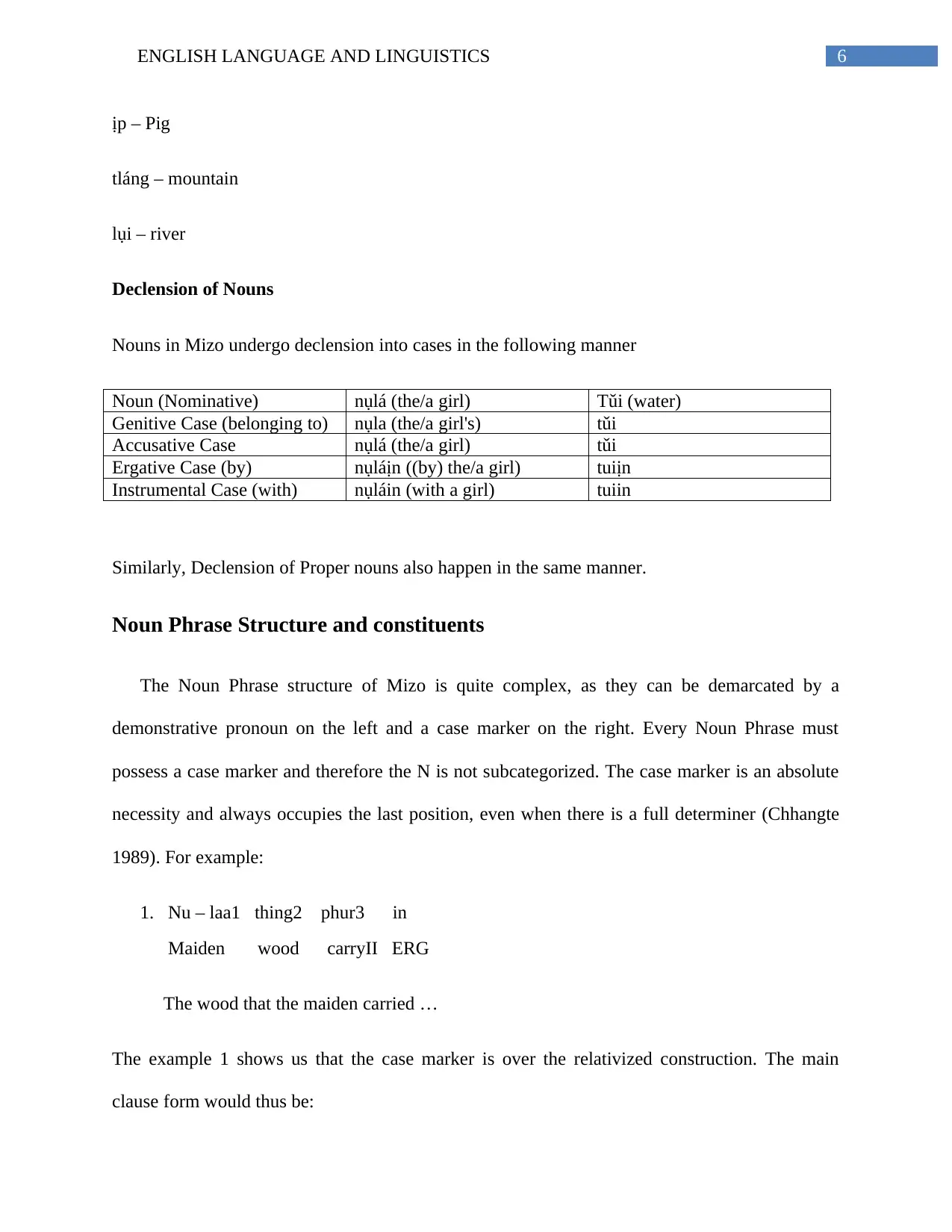
6ENGLISH LANGUAGE AND LINGUISTICS
ịp – Pig
tláng – mountain
lụi – river
Declension of Nouns
Nouns in Mizo undergo declension into cases in the following manner
Noun (Nominative) nụlá (the/a girl) Tǔi (water)
Genitive Case (belonging to) nụla (the/a girl's) tǔi
Accusative Case nụlá (the/a girl) tǔi
Ergative Case (by) nụláịn ((by) the/a girl) tuiịn
Instrumental Case (with) nụláin (with a girl) tuiin
Similarly, Declension of Proper nouns also happen in the same manner.
Noun Phrase Structure and constituents
The Noun Phrase structure of Mizo is quite complex, as they can be demarcated by a
demonstrative pronoun on the left and a case marker on the right. Every Noun Phrase must
possess a case marker and therefore the N is not subcategorized. The case marker is an absolute
necessity and always occupies the last position, even when there is a full determiner (Chhangte
1989). For example:
1. Nu – laa1 thing2 phur3 in
Maiden wood carryII ERG
The wood that the maiden carried …
The example 1 shows us that the case marker is over the relativized construction. The main
clause form would thus be:
ịp – Pig
tláng – mountain
lụi – river
Declension of Nouns
Nouns in Mizo undergo declension into cases in the following manner
Noun (Nominative) nụlá (the/a girl) Tǔi (water)
Genitive Case (belonging to) nụla (the/a girl's) tǔi
Accusative Case nụlá (the/a girl) tǔi
Ergative Case (by) nụláịn ((by) the/a girl) tuiịn
Instrumental Case (with) nụláin (with a girl) tuiin
Similarly, Declension of Proper nouns also happen in the same manner.
Noun Phrase Structure and constituents
The Noun Phrase structure of Mizo is quite complex, as they can be demarcated by a
demonstrative pronoun on the left and a case marker on the right. Every Noun Phrase must
possess a case marker and therefore the N is not subcategorized. The case marker is an absolute
necessity and always occupies the last position, even when there is a full determiner (Chhangte
1989). For example:
1. Nu – laa1 thing2 phur3 in
Maiden wood carryII ERG
The wood that the maiden carried …
The example 1 shows us that the case marker is over the relativized construction. The main
clause form would thus be:
Paraphrase This Document
Need a fresh take? Get an instant paraphrase of this document with our AI Paraphraser
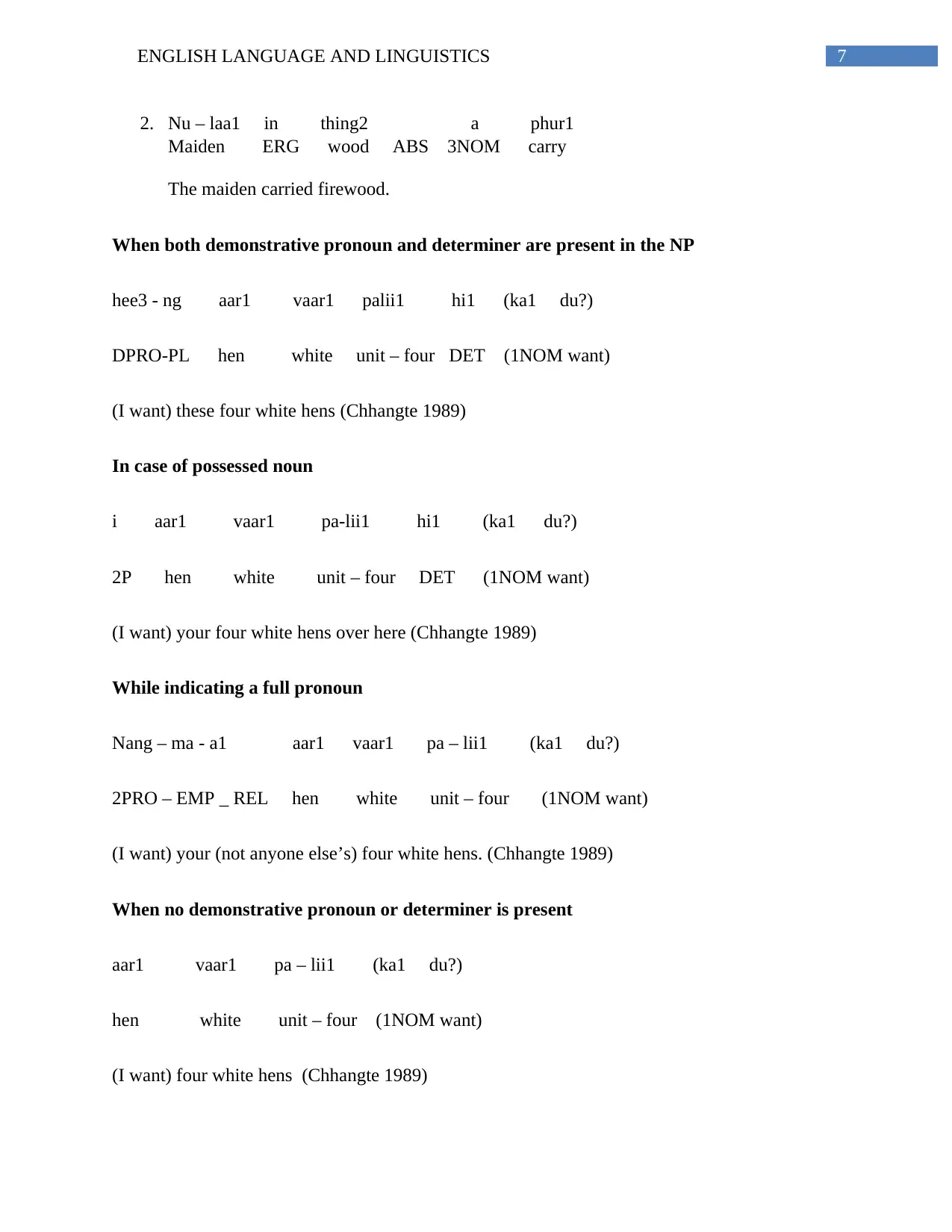
7ENGLISH LANGUAGE AND LINGUISTICS
2. Nu – laa1 in thing2 a phur1
Maiden ERG wood ABS 3NOM carry
The maiden carried firewood.
When both demonstrative pronoun and determiner are present in the NP
hee3 - ng aar1 vaar1 palii1 hi1 (ka1 du?)
DPRO-PL hen white unit – four DET (1NOM want)
(I want) these four white hens (Chhangte 1989)
In case of possessed noun
i aar1 vaar1 pa-lii1 hi1 (ka1 du?)
2P hen white unit – four DET (1NOM want)
(I want) your four white hens over here (Chhangte 1989)
While indicating a full pronoun
Nang – ma - a1 aar1 vaar1 pa – lii1 (ka1 du?)
2PRO – EMP _ REL hen white unit – four (1NOM want)
(I want) your (not anyone else’s) four white hens. (Chhangte 1989)
When no demonstrative pronoun or determiner is present
aar1 vaar1 pa – lii1 (ka1 du?)
hen white unit – four (1NOM want)
(I want) four white hens (Chhangte 1989)
2. Nu – laa1 in thing2 a phur1
Maiden ERG wood ABS 3NOM carry
The maiden carried firewood.
When both demonstrative pronoun and determiner are present in the NP
hee3 - ng aar1 vaar1 palii1 hi1 (ka1 du?)
DPRO-PL hen white unit – four DET (1NOM want)
(I want) these four white hens (Chhangte 1989)
In case of possessed noun
i aar1 vaar1 pa-lii1 hi1 (ka1 du?)
2P hen white unit – four DET (1NOM want)
(I want) your four white hens over here (Chhangte 1989)
While indicating a full pronoun
Nang – ma - a1 aar1 vaar1 pa – lii1 (ka1 du?)
2PRO – EMP _ REL hen white unit – four (1NOM want)
(I want) your (not anyone else’s) four white hens. (Chhangte 1989)
When no demonstrative pronoun or determiner is present
aar1 vaar1 pa – lii1 (ka1 du?)
hen white unit – four (1NOM want)
(I want) four white hens (Chhangte 1989)
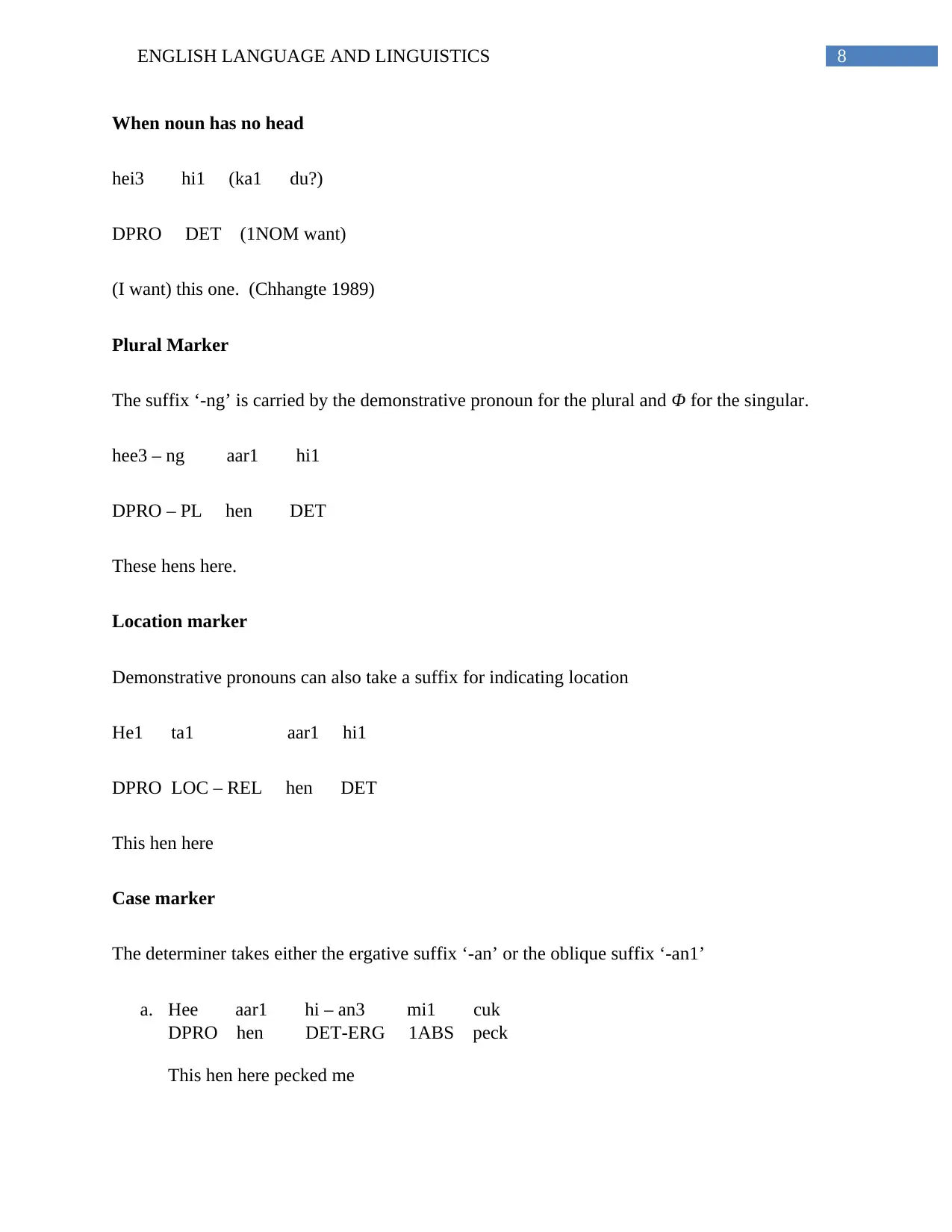
8ENGLISH LANGUAGE AND LINGUISTICS
When noun has no head
hei3 hi1 (ka1 du?)
DPRO DET (1NOM want)
(I want) this one. (Chhangte 1989)
Plural Marker
The suffix ‘-ng’ is carried by the demonstrative pronoun for the plural and Φ for the singular.
hee3 – ng aar1 hi1
DPRO – PL hen DET
These hens here.
Location marker
Demonstrative pronouns can also take a suffix for indicating location
He1 ta1 aar1 hi1
DPRO LOC – REL hen DET
This hen here
Case marker
The determiner takes either the ergative suffix ‘-an’ or the oblique suffix ‘-an1’
a. Hee aar1 hi – an3 mi1 cuk
DPRO hen DET-ERG 1ABS peck
This hen here pecked me
When noun has no head
hei3 hi1 (ka1 du?)
DPRO DET (1NOM want)
(I want) this one. (Chhangte 1989)
Plural Marker
The suffix ‘-ng’ is carried by the demonstrative pronoun for the plural and Φ for the singular.
hee3 – ng aar1 hi1
DPRO – PL hen DET
These hens here.
Location marker
Demonstrative pronouns can also take a suffix for indicating location
He1 ta1 aar1 hi1
DPRO LOC – REL hen DET
This hen here
Case marker
The determiner takes either the ergative suffix ‘-an’ or the oblique suffix ‘-an1’
a. Hee aar1 hi – an3 mi1 cuk
DPRO hen DET-ERG 1ABS peck
This hen here pecked me
⊘ This is a preview!⊘
Do you want full access?
Subscribe today to unlock all pages.

Trusted by 1+ million students worldwide
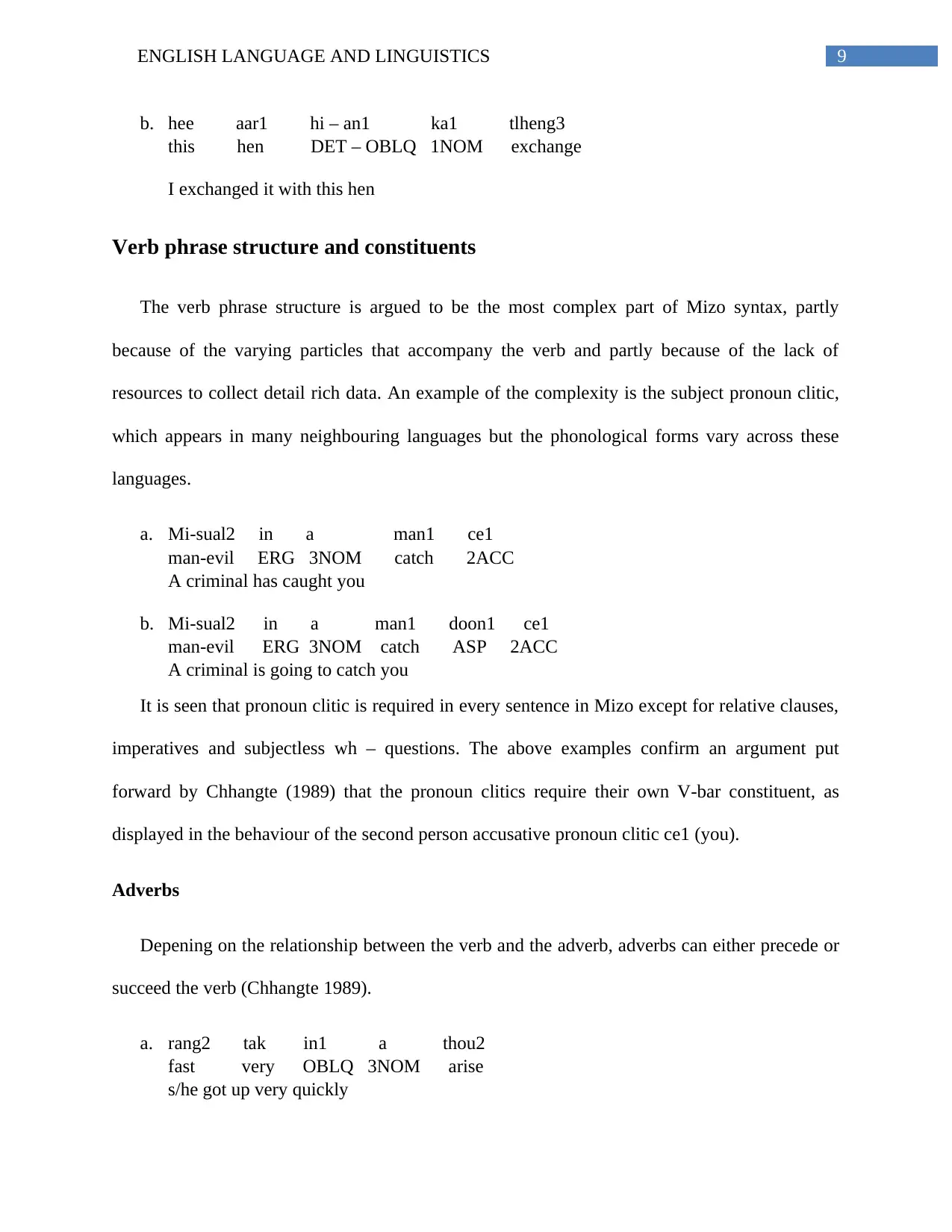
9ENGLISH LANGUAGE AND LINGUISTICS
b. hee aar1 hi – an1 ka1 tlheng3
this hen DET – OBLQ 1NOM exchange
I exchanged it with this hen
Verb phrase structure and constituents
The verb phrase structure is argued to be the most complex part of Mizo syntax, partly
because of the varying particles that accompany the verb and partly because of the lack of
resources to collect detail rich data. An example of the complexity is the subject pronoun clitic,
which appears in many neighbouring languages but the phonological forms vary across these
languages.
a. Mi-sual2 in a man1 ce1
man-evil ERG 3NOM catch 2ACC
A criminal has caught you
b. Mi-sual2 in a man1 doon1 ce1
man-evil ERG 3NOM catch ASP 2ACC
A criminal is going to catch you
It is seen that pronoun clitic is required in every sentence in Mizo except for relative clauses,
imperatives and subjectless wh – questions. The above examples confirm an argument put
forward by Chhangte (1989) that the pronoun clitics require their own V-bar constituent, as
displayed in the behaviour of the second person accusative pronoun clitic ce1 (you).
Adverbs
Depening on the relationship between the verb and the adverb, adverbs can either precede or
succeed the verb (Chhangte 1989).
a. rang2 tak in1 a thou2
fast very OBLQ 3NOM arise
s/he got up very quickly
b. hee aar1 hi – an1 ka1 tlheng3
this hen DET – OBLQ 1NOM exchange
I exchanged it with this hen
Verb phrase structure and constituents
The verb phrase structure is argued to be the most complex part of Mizo syntax, partly
because of the varying particles that accompany the verb and partly because of the lack of
resources to collect detail rich data. An example of the complexity is the subject pronoun clitic,
which appears in many neighbouring languages but the phonological forms vary across these
languages.
a. Mi-sual2 in a man1 ce1
man-evil ERG 3NOM catch 2ACC
A criminal has caught you
b. Mi-sual2 in a man1 doon1 ce1
man-evil ERG 3NOM catch ASP 2ACC
A criminal is going to catch you
It is seen that pronoun clitic is required in every sentence in Mizo except for relative clauses,
imperatives and subjectless wh – questions. The above examples confirm an argument put
forward by Chhangte (1989) that the pronoun clitics require their own V-bar constituent, as
displayed in the behaviour of the second person accusative pronoun clitic ce1 (you).
Adverbs
Depening on the relationship between the verb and the adverb, adverbs can either precede or
succeed the verb (Chhangte 1989).
a. rang2 tak in1 a thou2
fast very OBLQ 3NOM arise
s/he got up very quickly
Paraphrase This Document
Need a fresh take? Get an instant paraphrase of this document with our AI Paraphraser
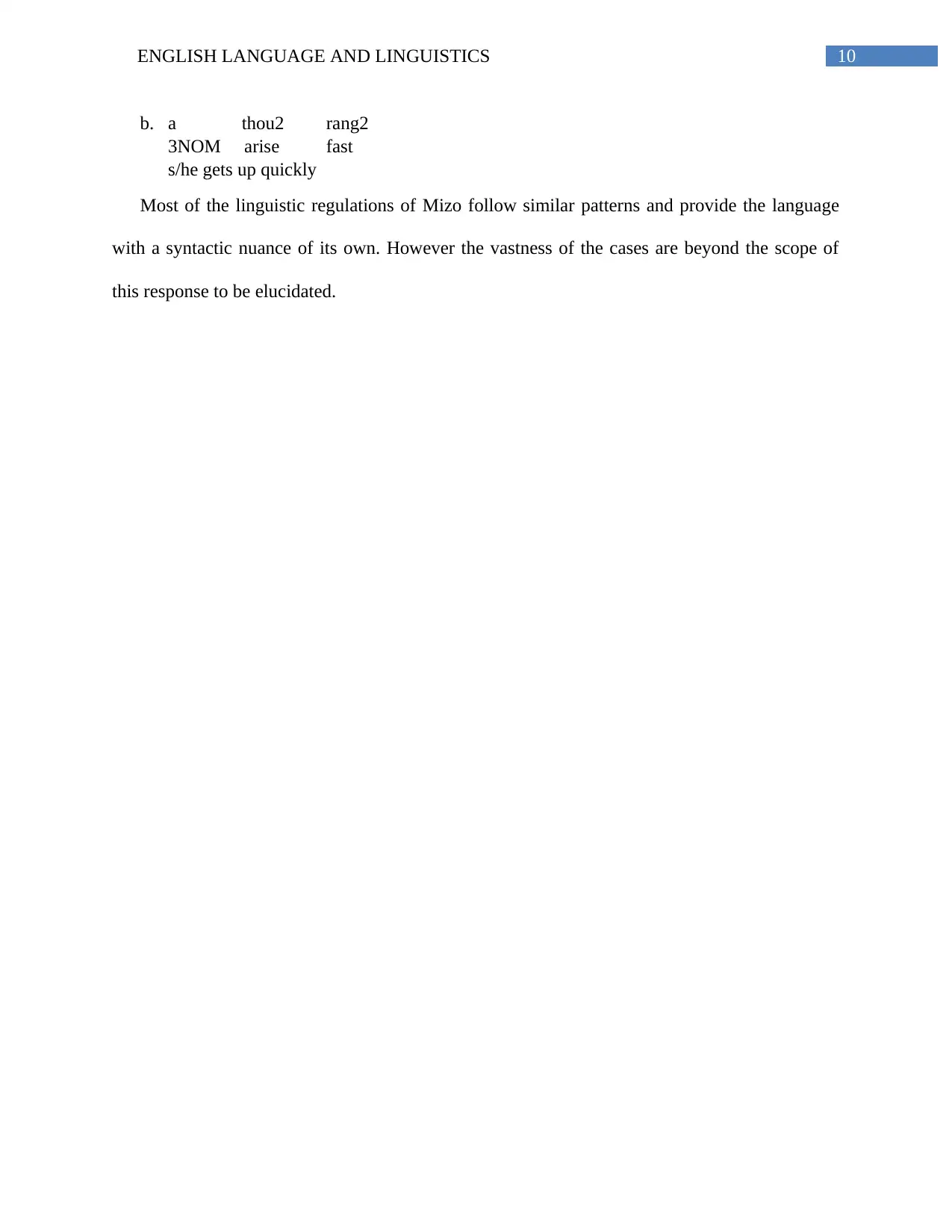
10ENGLISH LANGUAGE AND LINGUISTICS
b. a thou2 rang2
3NOM arise fast
s/he gets up quickly
Most of the linguistic regulations of Mizo follow similar patterns and provide the language
with a syntactic nuance of its own. However the vastness of the cases are beyond the scope of
this response to be elucidated.
b. a thou2 rang2
3NOM arise fast
s/he gets up quickly
Most of the linguistic regulations of Mizo follow similar patterns and provide the language
with a syntactic nuance of its own. However the vastness of the cases are beyond the scope of
this response to be elucidated.
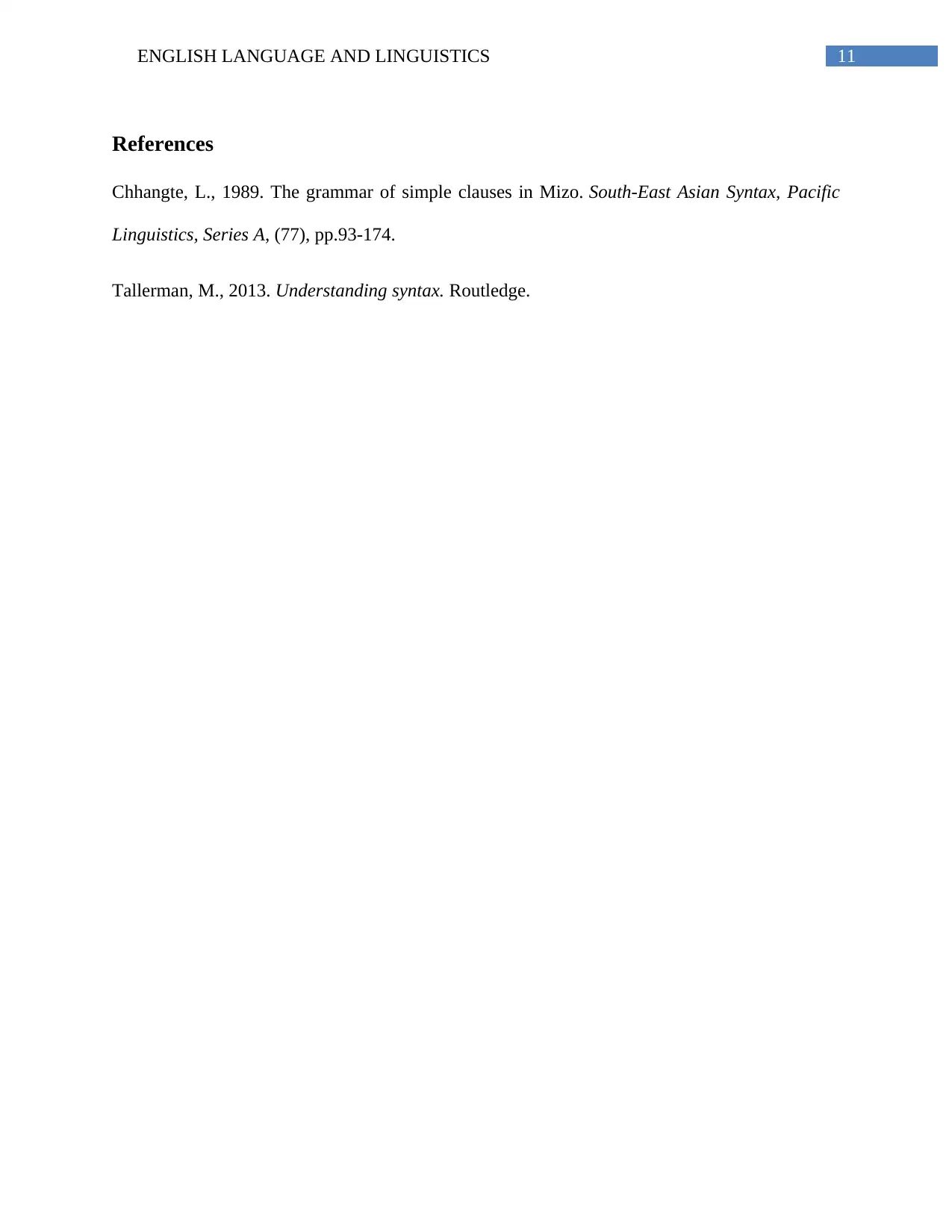
11ENGLISH LANGUAGE AND LINGUISTICS
References
Chhangte, L., 1989. The grammar of simple clauses in Mizo. South-East Asian Syntax, Pacific
Linguistics, Series A, (77), pp.93-174.
Tallerman, M., 2013. Understanding syntax. Routledge.
References
Chhangte, L., 1989. The grammar of simple clauses in Mizo. South-East Asian Syntax, Pacific
Linguistics, Series A, (77), pp.93-174.
Tallerman, M., 2013. Understanding syntax. Routledge.
⊘ This is a preview!⊘
Do you want full access?
Subscribe today to unlock all pages.

Trusted by 1+ million students worldwide
1 out of 12
Your All-in-One AI-Powered Toolkit for Academic Success.
+13062052269
info@desklib.com
Available 24*7 on WhatsApp / Email
![[object Object]](/_next/static/media/star-bottom.7253800d.svg)
Unlock your academic potential
Copyright © 2020–2025 A2Z Services. All Rights Reserved. Developed and managed by ZUCOL.


